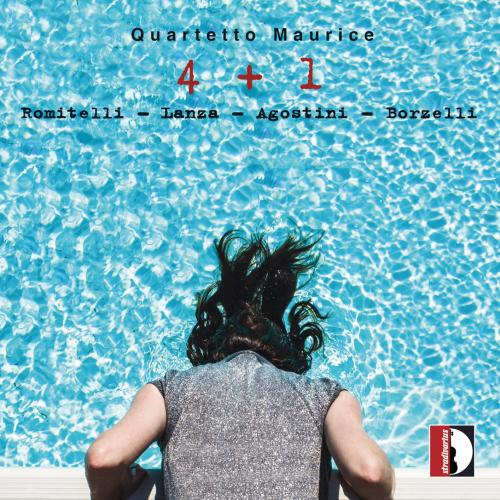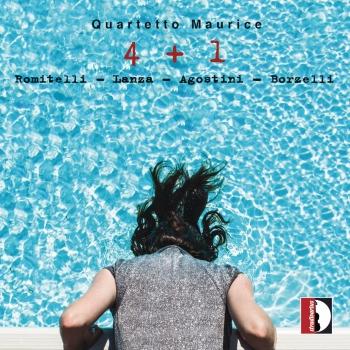
4 + 1 Quartetto Maurice
Album info
Album-Release:
2019
HRA-Release:
04.01.2019
Label: Stradivarius
Genre: Classical
Subgenre: Chamber Music
Artist: Quartetto Maurice
Composer: Giulio Colangleo (1987), Valerio Murat (1976), Steve Reich (1936), Ryan Carter (1981), Andrea Agostini (1975), Simon Steen Andersen (1976), Fausto Romitelli (1963-2004)
Album including Album cover Booklet (PDF)
- Fausto Romitelli (1963 - 2004):
- 1 Natura morta con fiamme 09:14
- Mauro Lanza (b. 1975):
- 2 The 1987 Max Headroom Broadcast Incident 10:40
- Andrea Agostini (b. 1965):
- 3 Legno sabbia vetro cenere 17:33
- Silvia Borzelli (b. 1978)
- 4 Earwitness (Familiar 2) 14:56
Info for 4 + 1
Those who have seen the Quartetto Maurice play live have seen this on their faces, in their gestures: the long sweetness and the angry acceleration, the smile and the serenity, the eurhythmy and the euphoria. The latter has often accompanied their wish that everything should change. We know that when we want everything to change, we evoke fire. Flame, Bachelard writes in an essay, is of all the objects that evoke reverie, one of the greatest operators of images: flame forces us to imagine. This is a truth that Fausto Romitelli knew well. Referring precisely to the synthetic work Natura morta con fiamme (1991), for string quartet and electronics, he explicitly refers to an imaginary scale, to an extremity which has a language without words, purely of relations, of which the essential elements are conventional and abstract, implemented by algebraic and combinatory processes. Dedicated to the memory of Fausto Romitelli, the piece by Mauro Lanza, The 1987 Max Headroom Broadcast Incident (2017), for augmented string quartet, reflects precisely on what lies beyond what we always see on the eye forced to watch and the ear forced to listen we could almost say on the reverie that admires interference. Andrea Agostini conceived Legno, sabbia, vetro, cenere (2009-10), for quartet and electronics. The composer formed the idea of using additive and deferred synthesis a technique that the composer is pleased to describe as very old to pursue an ideal he never then abandoned. This was writing electronics with a degree of control over detail and articulation of sound that aspires, one could say, to a very marked musical determinism. Silvia Borzelli searches for a profound explanation with Earwitness (familiar 2) (2017), for string quartet and stereo soundtracks. The earwitness of the title is the person described by Elias Canetti in that strange collection of stories that take their name exactly from the story of that name.
Quartetto Maurice
Quartetto Maurice
Since its formation in 2002, a constant and tireless research on sound has been the trait that has best distinguished the Quartetto Maurice. After an in-depth investigation of the traditional classical repertoire, which has guaranteed a meticulous approach to the score and an extreme attention to the performance’s details, the Quartet showed the need to place the music of 20th and 21th centuries at the heart of its repertoire, exploring a great variety of contemporary languages.
The 4+1 project – where «4» stands for the string quartet and «1» is for electronics – highlights the will of the Quartetto to consider electronics as the full fifth member of the group, and to emphasize its «cameristic» aspect, capturing the suggestions offered by electronics, giving it a new relevance in the acoustic environment, and finally creating a flow of innovations in sound that resonates one with each other.
Over the years, the Quartetto Maurice carried out an intensive training in the contemporary music repertoire, together with the greatest performers and composers of the international scene. It is active in promoting new music through commissions to young composers, keeping an open mind on the complex contemporary music panorama.
Regularly invited to perform at the most important festivals and concert seasons across Europe, North and South America, the Quartet has performed through Italy and abroad, in a number of prestigious venues including the Venice Biennale, November Music Festival in 's-Hertogenbosch (Holland), the Biennale Zagreb, the Festival Mixtur in Barcelona (Spain), the Bludenzer Tage zeitgemäßer Musik 2017, the Italian Academy of Columbia University in New York (USA ), the Italian Istitut of Culture and for ProQuartet in Paris, the Festival Tzlil Meudcan in Tel Aviv (Israel), the Distat Terra festival in Argentina, the New Music Festival in Macerata (italy), the International Fajr Music Festival in Tehran (Iran), Open Music in Graz (Austria).
The Quartetto received the support of several institutions such as De Sono – Associazione per la Musica (Turin), Freunde und Förderer des Internationalen Musikinstituts (Darmstadt), ProQuartet Association (Paris), CIDIM (Comitato Nazionale Italiano Musica). It has been selected to partecipated in the workshop for quartet+electronic in the framework of the Ulysses-Journeys during "ManiFeste 2017", supported by IRCAM. The Quartet is participating to the project "Le dimore del quartetto", in collaboration with ADSI.
The Quartetto won the 35th Italian Music Critics Award «Franco Abbiati» dedicated to the memory of Piero Farulli in 2015 and the Kranichsteiner Stipendium Preis at the 48th Ferienkurse fur Neue Musik in Darmstadt in 2016.
Booklet for 4 + 1









